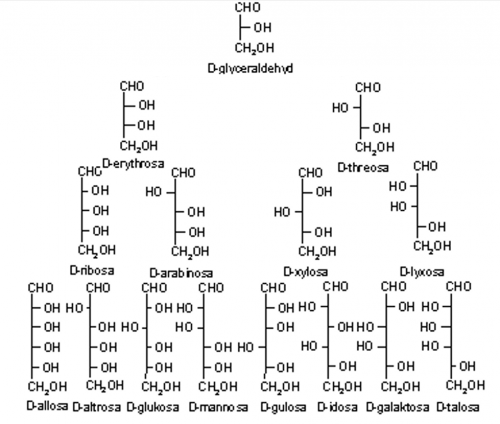Interesting facts from the world of organic chemistry
Derivatives - carbohydrates:
SOS and Fisher formulas of D-aldoses
This article will not discuss a specific compound, but a group as such. Actually, it will rather be about logical connections and relationships existing in the field of Fisher formulas of D-aldoses. This is such a learning aid for deriving the Fisher formulas of D-aldoses. However, analogous rules also apply in the case of D-ketoses. I probably wouldn’t call it anything other than an aid for creating the formulas of some carbohydrates. The consideration of this issue fascinated me more than some otherwise interesting properties of some carbohydrates.
Aldoses are monosaccharides derived from glyceraldehyde. Since glyceraldehyde has an optically active carbon (C2), it can exist in two forms, either (S)- or (R)-glyceraldehyde. In the Fisher formula, the absolute configuration (S)- is drawn with the hydroxyl group on the left (hence then L-glyceraldehyde), with the (R)- configuration then on the right (D-glyceraldehyde). The aldose configuration, which has a total of more than three carbons, is based on the glyceraldehyde configuration. If the last chiral carbon of a given aldose has the same configuration as that of (R)-glyceraldehyde (or D-glyceraldehyde), then it is a D-aldose and vice versa. It is the D-aldoses that are the most interesting for us, because compared to their L-forms, they are much more widespread in nature. The derived “tree” of individual D-aldoses is shown in the figure.

Picture above: A multi-step system for deriving Fisher formulas of D-aldoses.
From the above-mentioned pyramid of successive derivations, relatively obvious but unforgettable logical dependencies can be traced in terms of the orientation of hydroxyl groups on optically active carbons, except for the last one (again, it only decides whether the aldose will be L- or D-).
The relative location of the hydroxyl group on the observed optically active carbons (C2 and C3) in the case of aldopentoses is summarized in Table I. Relativity is based on and based on the configuration on the last optically active carbon, relative (E/Z) configuration is not meant here!

Table above: Summary of the orientation of the OH groups on the C2 and C3 carbons in D-aldopentoses relative to the C4 carbon.
“S” means “same”, “O” means “opposite” (orientation).
The table shows that in the case of D-aldopentoses (in the order of RAXL names) the alternation of absolute configurations relative to C4 is regular (SO, SO) on the C2 carbon, and in pairs (SS, OO) on the C3 carbon.
The meaning of the alternation of absolute configurations on the observed optically active carbons (C2-C4) in the case of aldohexoses is summarized in Table II. Again, I emphasize that relativity is based on and based on the configuration on the last optically active carbon, it is not a relative (E/Z) configuration.

Table above: Summary of relative orientations of OH groups on carbons C2-C4 in D-aldohexoses relative to carbon C5.
“S” means “same”, “O” means “opposite” (orientation).
The above table shows that for D-aldohexoses (in the order of names ALL-A-GLU-MA-GUL-I-GA-TA) there is a regular alternation of absolute configurations relative to C4 on the C2 carbon (SO, SO,…) , on the C3 carbon again in pairs (SS, OO,…) and on the C4 carbon the same position of the OH group as on C5 is first four times in a row and then the opposite four times.
Conclusion
In other words, to create the Fisher formula from the name of D-aldopentose or D-aldohexose and vice versa, it is enough to know:
“R-A-X-L” and
“ALL-A-GLU-MA-GUL-I-GA-TA”
(which by the way sounds like some kind of incantation “alaglumaguligata!”)
and know that:
on carbon C4, or C5, is the OH group on the right (this is D),
further that the first saccharide always has all OH groups oriented in the same way as the last optically active carbon
and know the relevant patterns in the individual rows (on C2 is SO, on C3 is SSOO and possibly on C4 is 4S and then 4O).
If you know these conceptual rules, you can easily create all the Fisher formulas of D-aldopentoses or D-aldohexoses from memory. I myself know that by creating these “tutorials” I passed more than one organic test (or the few examples where this knowledge was needed 🙂 ).
Analogous relationships apply to D-ketoses and, in general, to L-forms.
A small note at the end. D- and L- symbols are legally written 1-2 points smaller than the surrounding font. In the text, they are written in the same font size for simplicity during editing.
Sources:
[1] (scheme of carbohydrates only) „Borovicka.name,“ [Online]. Available: http://borovicka.name/lib/exe/fetch.php?media=school:fbmi:bbblg:vypisky:aldosy.gif. [Přístup získán 8 6 2013].
